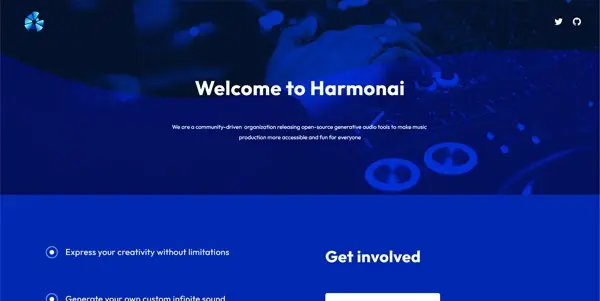Harmonai

An open source AI that creates infinite music
Harmonai: An Open-Source AI for Infinite Music Creation
Harmonai is a groundbreaking open-source artificial intelligence tool dedicated to the generation of limitless musical compositions. It represents a significant advancement in AI-driven music creation, offering users a powerful and accessible platform for exploring new sonic landscapes. This article delves into Harmonai's capabilities, features, applications, and how it stacks up against similar tools.
What Harmonai Does
Harmonai's core function is to generate original musical pieces. Unlike simpler music generation tools, Harmonai goes beyond simple melodies or chord progressions. It aims to create complete, structured musical pieces with a degree of complexity and coherence that rivals human composition. This is achieved through sophisticated machine learning models trained on vast datasets of musical scores and audio. The tool allows users to influence the generated music through various parameters and constraints, enabling a high degree of creative control.
Main Features and Benefits
- Infinite Music Generation: The tool's name accurately reflects its capabilities – it can generate virtually limitless unique musical pieces. This is particularly beneficial for tasks requiring a diverse range of musical content.
- Open-Source Nature: Harmonai's open-source nature allows for community contributions, ensuring ongoing development and improvements. This also facilitates transparency and allows users to understand the underlying algorithms and potentially adapt them to their specific needs.
- Parameter Control: Users can adjust various parameters to influence the generated music's style, tempo, key, instrumentation, and overall structure. This allows for a tailored approach to music creation, catering to diverse musical preferences and project requirements.
- Customizability: The open-source nature means developers can modify and extend the tool's functionality, adding new instruments, styles, or generation algorithms.
- Ease of Use: While the underlying technology is complex, Harmonai aims to provide a relatively user-friendly interface, making it accessible to a broader audience, even those without extensive music theory knowledge.
Use Cases and Applications
Harmonai's potential applications span numerous fields:
- Game Development: Generating unique soundtracks and background music for video games, removing the need for extensive manual composition.
- Film and Television: Creating custom soundtracks and underscore music for film and television productions, offering a cost-effective and efficient solution.
- Interactive Music Installations: Developing dynamic and responsive musical installations that adapt to user input or environmental changes.
- Music Education: Providing students with a tool for exploring musical concepts and experimenting with different styles and structures.
- Content Creation: Generating unique musical pieces for podcasts, YouTube videos, and other online content.
- Research: Serving as a platform for research into AI-driven music composition and the underlying machine learning algorithms.
Comparison to Similar Tools
Harmonai distinguishes itself from other AI music generators in several key aspects: its open-source nature, its focus on generating complete and complex musical pieces, and the level of parameter control offered to the user. While other tools may excel in specific niches (e.g., generating simple melodies or specific genres), Harmonai aims for broader applicability and versatility. A direct comparison requires specifying the specific alternative tools being considered, but key differentiators generally include licensing costs, level of user control, and the complexity of generated music.
Pricing Information
Harmonai is completely free to use. The open-source license makes it accessible to anyone, fostering collaboration and development within the community. This contrasts with many proprietary AI music generation tools that typically require subscriptions or one-time purchases.
In conclusion, Harmonai represents a significant leap forward in the field of AI-driven music creation. Its open-source nature, combined with its powerful generation capabilities and user-friendly interface, makes it a valuable tool for a wide range of applications. Its free access further democratizes music creation, opening up exciting possibilities for both professional musicians and aspiring composers alike.